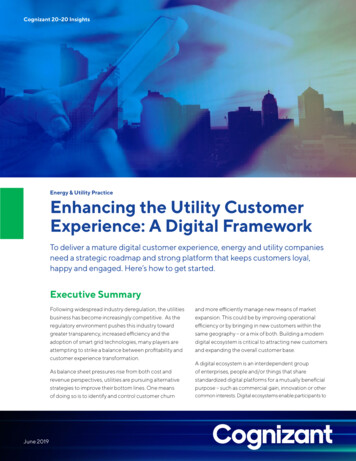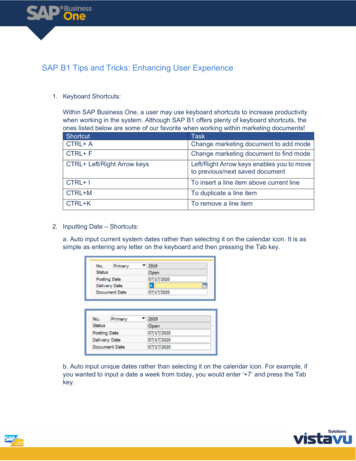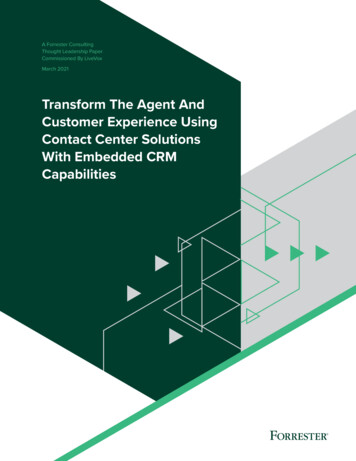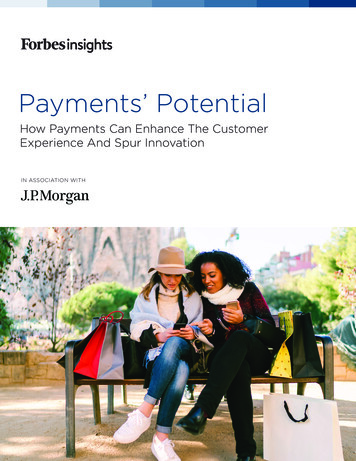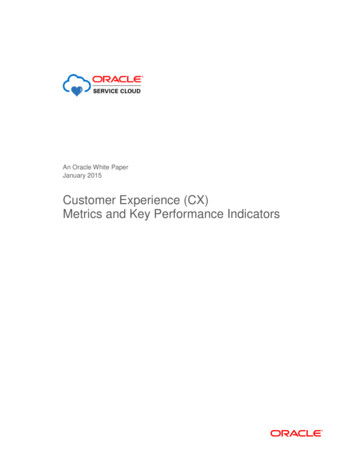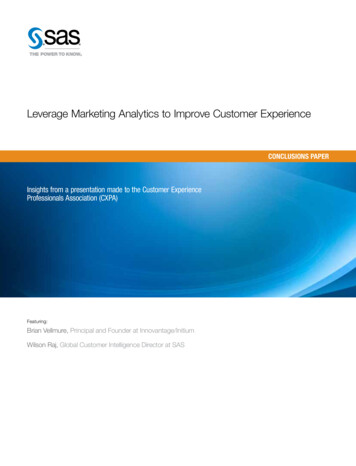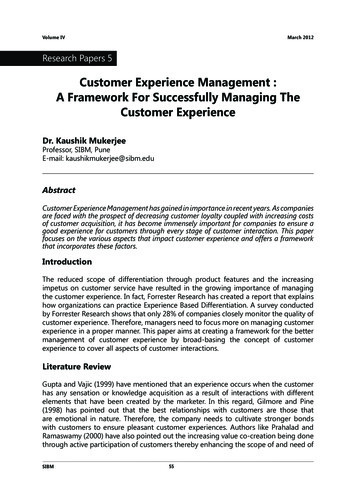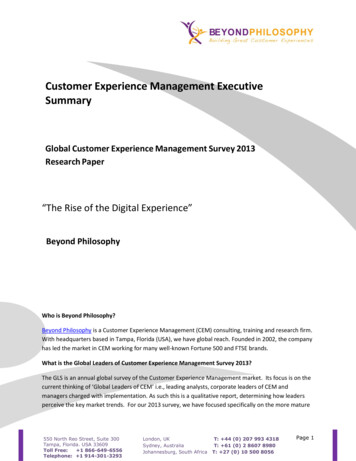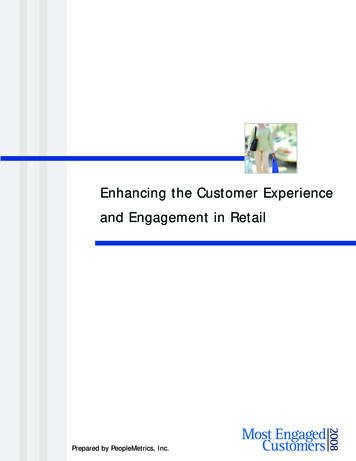
Transcription
Enhancing the Customer Experienceand Engagement in RetailPrepared by PeopleMetrics, Inc.
Table of ContentsIntroduction1Research Methodology1Key Findings4Does Customer Engagement Impact Business Performance?4Taking a Closer Look at the Retail Sector4Which Brands Have the Most Engaged Customers Today?6Additional Insights from the Research7Implications for the Reader8Appendix: List of Brands10Copyright 2008 PeopleMetrics Inc.
RIntroductionEnhancing Customer Satisfaction and Loyaltyhas been an area of focus for managers,business leaders, academics and researchconsultants for more than two decades. Theadvantages of focusing on enhancing customerloyalty are well understood, and compellingstatistics around the costs associated withkeeping an existing customer versus attracting anew one abound. As customer loyalty increases,so does share of spend in a given category,positive word-of-mouth, and retention rates.To monitor performance and focus improvementefforts, many organizations rely on customerfeedback systems. Today, a variety of disparatemeasures exist across these feedback systemswhen assessing loyalty. Some organizations stilluse customer satisfaction as a proxy for loyalty;others rely on the Net Promoter Score (anadvocacy based measure); still othersincorporate retention measures to gauge statedloyalty and link it to actual behaviors.Since our inception in 2000, PeopleMetrics hasplayed an important role in the evolution ofcustomer loyalty measurement, interviewingclose to 600,000 customers in serviceindustries. Over the years, the findings from ourprimary and secondary research have led us tothe development of our Customer Engagementmodel.The PeopleMetrics Customer Engagementmodel takes today’s common metrics of ‘loyalty’to a different level. Not only do we track acustomer’s willingness to return to andrecommend an organization, but we also assesswhether or not a customer would go out of hisway to continue doing business with a companyand if he feels passion, even love, for the brandand experience.Our point of view is that organizations should gobeyond providing a satisfactory experience tocustomers. They should instead strive toengage them by developing a rational andemotional connection. As this is accomplished,an engaged customer will have a strong bondwith the company, making it harder forcompetitors to attract them.To understand the role of CustomerEngagement in the service industry today,PeopleMetrics launched The Most EngagedCustomers Study in 2008 1. This annual studyfocuses on: Quantifying the impact that CustomerEngagement has on businessperformance Identifying the key drivers of CustomerEngagement and industry differences Ranking companies according to levelsof Customer EngagementInformation on our approach and keyresearch findings follow.Research MethodologySample ProfileOverall StudyPartnering with Greenfield Online, PeopleMetrics conducted close to 10,000 online interviewsacross four service-based industries: CasualDining, Hotels, Retail and Banking.To ensure a diverse representation in our study,PeopleMetrics and Greenfield reached out to anationally representative sample of the USpopulation. The final distribution of customersacross main groups is within /- 10 points ofthe U.S. Census figures. This was expectedupon a review of the brands that customers2were asked to rate : half of the company listconsisted of Retail stores and many of these, forinstance, were skewed towards female buyers.Still, as illustrated by the charts included on thefollowing page, the overall representation ofdifferent demographic groups is strong and,most importantly, in line with the profile ofcustomers of the brands included.12Data for The Most Engaged Customers Study (2008) was collected in Q3 2007.A comprehensive list of brands included in the study is provided in the appendix.Copyright 2008 PeopleMetrics Inc.1
RStudy emale60%17%12%10%0%L e s s th a n 2 5 K 2 5 K to 5 0 K 5 0 K to 1 0 0 K 100K Age50%US stMidwest33%West0%Under 24 yrs25 to 44 yrs45 to 59 yrs60 yrsRetail IndustryWith regard to the Retail industry, 5,644 interviews were completed among customers of thefollowing brands:A bercrom bie & F itchH ertz R ent A C arA éropostaleJ. C rewA lam o R ent A C arA m erican E agle O utfit tersJC P enneyK ohl'sA nn T aylorM acy'sA vis R ent A C arT he TJX C om paniesB arnes & N obleM en's W earhouseB ed B ath & B eyondB est B uyN ine W estN ordstromB ig LotsO ffice D epotB J's W holesale C lubP ayless S hoesB udget R ent A C arP etS m artC hico’sP ier 1 Im portsC ircuit C ityR adioS hackC laire's B outiqueR ossC ostcoS aks F ifth A venueD illard'sS earsD ollar G eneralS taplesD ollar T hriftyT argetD ollar T reeT he G apE nterprise R ent A C arT he Lim itedF am ily D ollarU rban O utfittersF oot LockerW al- M artG am eS topW illiam s- S onom aSurvey DesignThe survey asked customers to rate two of over100 service providers on a recent (within thelast three months) service experience along anumber of dimensions. Specifically, questionsrelated to: Overall levels of Customer Engagement (Retention, Effort, Advocacyand Passion) Functional elements of the serviceexperience: quality and variety ofproducts and services, cleanliness,appearance of service setting, andoverall efficiency of the serviceprocess. Emotional elements of the serviceexperience: problem resolution,company reputation, brand, employeeattitudes and behaviors. Open-ended commentary: Actionstaken because of an outstanding orpoor service encounter, reasons forGUESSCopyright 2008 PeopleMetrics Inc.2
RThe PeopleMetrics Customer Engagement ModelEMOTIONAL DIMENSIONSAUTHENTICENGAGEMENT OUTCOMESATTENTIVEENGAGED EMPLOYEESR eten tio nREPUTATIONE xtra E ffo rtACCOUNTABLEB U S IN E S SRESULTSA d vo cac yVALUEDP assio nFUNCTIONAL DIMENSIONSSERVICE DELIVERYSERVICE/PRODUCT QUALITYfeeling passionately connected to anorganization and detailed descriptionof problem experiences.average level of Engagement for eachcompany in the study and definedhigh performers as those withEngagement at least two pointsabove the average and low performers with Engagement at least twopoints below the average (AverageEngagement Index 54%). Companies that did not meet our criteriawere excluded from the analysis.The graphic above depicts the PeopleMetricsCustomer Engagement Model that consists ofeight overall dimensions: six emotional and twofunctional in nature. Questions in the studywere asked in support of these.Financial AnalysisTo gain insight into the relationship betweenCustomer Engagement and Business Performance, we conducted a financial analysisamong customers of all publicly traded companies included in the study. Key steps in thisanalysis are listed below:Step 1: Identifying High and Low PerformersThe first step in this analysis was to segment allbrands into high and low performers basedupon their Customer Engagement Index (%Engaged Customers3). To accomplish this, we calculated theStep 2: Gathering Financial DataFor each publicly traded corporation4, the following year-over-year (Q3 2006 to Q3 2007) financials were gathered: Return on AssetsReturn on InvestmentRevenue GrowthP/E RatioEPS (Earnings per Share)Step 3: Correlating Engagement to FinancialsThe next and final step was to determine theaverage financial score for each metric across3Engaged Customers are defined as those who Agree or Strongly Agree with ourfour Engagement Questions (Retention, Effort, Advocacy and Passion)4Engagement scores for brands from the same parent company were combinedtogether in this analysis.Copyright 2008 PeopleMetrics Inc.3
Rcompanies in the low vs. high CustomerEngagement groups and compare the performance of these groups. The average P/E ratio of highperforming companies is 14% aboveEngagement & Performancethe industry average, while lowperforming compa62%nies stand at 18%46%below the industryaverage.Key FindingsDoes CustomerEngagement ImpactBusiness Performance?As discussed above, companieswere classified into two groupsbased on their Engagementlevels. As described in theillustration on the right, thereis a 16-point gap in Engagement levels between thosethat perform well (62%) andthose that perform poorly (46%).companies experience is 36% belowthe industry overall figure.100%80%60%40%20%0%Low PerformersHigh PerformersTaking a Closer Look at the Retail SectorImpact of Customer Engagement on BusinessPerformance in the Retail SectorBased on the results of this analysis, we wereable to validate our hypothesis that companieswith high levels of Customer Engagementperform better financially than companies withlow levels of Customer Engagement.The financial analysis was also conducted withinthe Retail sector. Trends observed in the overallanalysis held true across this sector: Retail chains with low CustomerEngagement also perform below theindustry average across the financialmetrics analyzed.Across all financial metrics analyzed, companies with high Customer Engagement outperform the industry average. High-performing companies are ableto yield an annual average increaseof 8% on Return on Investmentabove theindustry aver100%age, whilelow-performing80%companiesexperience a60%23% decreasebelow the40%industry aver20%age. The annualrevenue growthfor highperformingcompanies is13% above theindustry average, while theaverage forlow-performingComparisons for the financialmetrics analyzed are illustratedin the chart below. High-performing companies are ableto yield an annual average increaseImpact of Customer Engagement on Business -36%-60%Return onAssetsReturn onInvestmentRevenueGrowthLow Customer EngagementCopyright 2008 PeopleMetrics Inc.P/E RatioEarnings perShareHigh Customer Engagement4
Rof 3% on Return on Investmentabove the industry average, whilelow-performing companies stand22% below the industry average. Companies with high CustomerEngagement levels experience anaverage increase that is 8% abovethe industry average on Return onAssets year-over-year, while lowperforming companies typically seea decrease 23% below the industryaverage. The average P/E ratio of highperforming companies is 25% abovethe industry average, while lowperforming companies stand at 17%below the industry average.Additional Insights into Customer Engagementin the Retail SectorTo identify trends specific to the retail industry,a separate analysis was undertaken focusingon perceptions and feedback from customersof the retail companies included in the study(see page 2 for a complete listing).The main research questions driving our effortswere:1) What can retail establishments doto improve Customer Engagementlevels?2) Do the drivers of CustomerEngagement for retail shoppersdiffer from the overall drivers ofCustomer Engagement? If so, howare they different?3) Which brands have the MostEngaged Customers today?What can retail establishments do to improveCustomer Engagement levels?Having confirmed the direct relationshipbetween Customer Engagement levels and5financial performance, a driver analysis wasconducted to identify the most influentialfactors impacting Customer Engagement in theRetail Sector.The analysis showed that Customers areengaged most by emotional drivers, with onefunctional area playing a key role:Emotional Dimension #1 - The Need to beValuedCustomer Engagement is largely driven by thestaff’s ability to enhance their customers’self-esteem. Providing consistent servicequality, valuing customers and fulfilling promises positively impacts levels of Engagement.Emotional Dimension #2 - The Impact ofEngaged EmployeesEngaged employees have a direct impact onCustomer Engagement as well. An engagedstaff member will go the extra mile to offer apositive customer experience.Employeeengagement is best portrayed by employeeswho love their jobs, make the customer experience fun and go above and beyond expectations.Functional Dimension #1 - The Quality of theService EnvironmentThe actual environment of any establishment isalso a key driver of Customer Engagementwithin the retail sector. The variety of offeringsavailable and the convenience of the store areessential to securing Engaged customers.Do the drivers of Customer Engagement for retailshoppers differ from the overall drivers ofCustomer Engagement? If so, how are they different?The table shown on the next page compares theCustomer Engagement drivers within Retail tothe overall drivers of Customer Engagement forall service industries (which also take intoaccount Casual Dining, Banking and Hotels).As can be noted, there is a fair degree of overlap between the two. This confirms that,regardless of industry, Customer Engagement isimpacted by more than just the functionalelements of the experience and can be maximized through the development of an emotionalconnection with customers.5 Multiple regression techniques were employed to help uncover the key drivers of Customer Engagement. A key driver isan area that, if worked upon, will have a significant impact on levels of Customer Engagement – it is the “make adifference” element of the customer relationship when it comes to driving desired attitudes and behaviors.Copyright 2008 PeopleMetrics Inc.5
RE n g a g e m e n t D im e n s ion : S u rve y Ite mS e rvic e Q u a lity :Th e re w a s an a p p ro p ria te va rie ty o f p ro d uct/se rvice o ffe ring sV a lu e d : In ge n e ral, th e em p loye e s I in te ract w ith va lue m e as a cu sto m e rV a lu e d : In ge n e ral, th e em p loye e s I in te ract w ith p ro vid e a co n sisten t le ve l o fse rvice q u alityS e rvic e Q u a lity: In g e n e ral, C O M P A N Y is co n ve nie n tV a lu e d : In ge n e ral, th e em p loye e s I in te ract w ith m a ke g oo d o n the ir p ro m isesE n g a g e d E m p lo ye e s: E m p loye e s m a d e th e e xp e rie nce fu nE n g a g e d E m p lo ye e s: E m p loye e s w e n t a b o ve a n d b e yo n d to m ee t m y ne e dsS e rvic e D e live ry:Th e S e rvice P ro cess w a s efficien tV a lu e d : In ge n e ral, th e em p loye e s I in te ract w ith trea t all custo m e rs e q ua llyS e rvic e Q u a lity :Th e E n viro n m e n t: Th e loca tio n /se ttin g w a s clea nWhich Brands Have the Most EngagedCustomers Today?Out of the forty-nine Retail brands included inour study, Williams-Sonoma and J. Crew havethe highest Customer Engagement scorestoday.Supporting our findings on what drivesCustomer Engagement, customers from thesetwo brands praise the staff and the quality ofthe service received at these locations. Belowis a sample of the comments from customerswho “love” shopping at these top performingcompanies: “Their staff is knowledgeable,caring and they really know how towork with the customer.”(Williams-Sonoma Customer) “The personnel greet you warmly.The ambience of the store iswonderful. They make me feel athome.” (Williams-SonomaCustomer) “[The] staff is helpful, and hascreated a relationship with me.” (J.Crew Customer) “The sales people are engaging,creative and enthusiastic about theclothing.” (J. Crew Customer)Customer Engagement rankings by Retailsub-categories are provided to the right and onthe following page:D rive r R a n kA llR e ta ilIn d u s tries12213345678910465879A p p a rel123456789101112J. C rewN ine W estA nn T aylorA éropostaleC hico'sGUESSA m erican E agle O utfittersA bercrom bie & F itchT he Lim itedT he G apU rban O utfittersM en's W earhouseF oot LockerD ep artm en t S to re s1234567JC P enneyS aks F ifth A venueN ordstromK ohl'sD illard'sM acy'sS earsD isco u n t S to res1234567891011C ostcoD ollar T reeB J’s W holesale C lubB ig LotsT he TJX C om paniesP ayless S hoesF am ily D ollarR ossD ollar G eneralT argetW al-M artR en tal & L e asin g123456Copyright 2008 PeopleMetrics Inc.A vis R ent A C arH ertz R ent A C arE nterprise R ent A C arD ollar T hriftyB udget R ent A C arA lam o R ent A C ar6
R123456781234S p ecialtydevelopment of an emotionalconnection with customers.W illiam s -S onom aB arnes & N obleP etS m artP ier 1 Im portsB ed B ath & B eyondS taplesC laire's B outiqueO ffice D epotT ech n o lo g yG am eS topC ircuit C ityB est B uyR adioS hackAdditional Insights from the Overall ResearchThe wealth of data collected through thisresearch has also given us the opportunity tostudy trends across sub-groups and explore theimpact of service experience on CustomerEngagement levels. A few additional insightsthat may help target research efforts to different audiences and guide the interpretation ofresults are: Overall, 54% of customersnationally can be consideredengaged. Older customers (60 years) areless likely to be engaged thanyounger customers. Engagement levels vary byindustry.o Out of the industries includedin our research, Hotelsyielded the highest levels ofCustomer Engagement, whileBanking yielded the lowest. Drivers of Engagement do not varygreatly across industries.o The overlap betweenindustry-specific drivers andoverall drivers of Engagementis evidence that, regardless ofindustry, CustomerEngagement is impacted bymore than just the functionalelements of the experienceand is maximized through the Through word-of-mouth, bothengaged and disengagedcustomers will influence the opinionof potential customers.o In addition to developing abond with the organization, aportion of engaged customerswill also speak publicly abouttheir experiences. A fewexamples are included below: “I have posted a critiqueon their site about hownice [they] are.” “On Yahoo! Answers, Itold someone asking forthe best [type ofcompany] to go withthem.”o Similarly, actively disengagedcustomers also spread theirpoor opinions publicly: “I have called thecompany more thanonce. I have postedopinion polls online. Ihave emailed thecompany. I havecontacted the [company]directly and I have toldfriends and family theproblems that I have hadwith them.” “I called and spoke with[the] manager, discussed[my] experience withfriends and family, andalso posted on nationaland local discussionforums regarding theexperience.” Other actions taken by activelydisengaged customers include:bringing the negative experience tothe attention of the organization’smanagers or to customer service,as well as often saying that theywill “never return.” A successful problem recrecoveryCopyright 2008 PeopleMetrics Inc.7
Rprocess is essential in maintainingyour customer base: more thanhalf of customers who experience aproblem that is handled well by theorganization are engaged. On thecontrary, only 15% of those whodo not believe that the organizationhandled their problem well areengaged customers.Implications for the ReaderClearly, a focus on Customer Engagement willmake a difference to your business. Retailestablishments that engage more of theircustomers have better financial results thanthose that fail to engage. Engagement is goingto be impacted by a combination of functional(convenience, cleanliness, choice, efficiency)and emotional (feeling valued, having fun, trusting in the consistency of service delivery)elements of the experience.In thinking about how this research applies toyour business, you should consider the following:1) Do you know how engaged yourcustomer base is?- More than a single measure ofadvocacy or retention, CustomerEngagement introduces anemotional element to themeasurement process. Are youcurrently measuring theseemotional pieces? Do you knowwhat proportion of yourcustomer base would stronglyagree that they would go out oftheir way to visit one of yourlocations, recommend you,come back, and feel passionateabout you and your brand?2) Do you know how your customerssegment based upon Engagement?- It is important to know youroverall level of Engagement, butalso to uncover the proportionof customers who are: fullyengaged, engaged, on the fenceand actively disengaged. Thosein the lowest segment canspread viral word-of
Partnering with Greenfield Online, PeopleMet-rics conducted close to 10,000 online interviews across four service-based industries: Casual Dining, Hotels, Retail and Banking. To ensure a diverse representation in our study, PeopleMetrics and Greenfield reached out to
